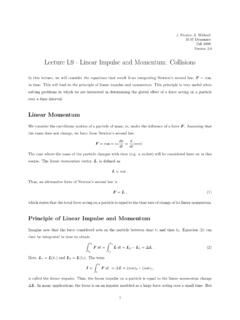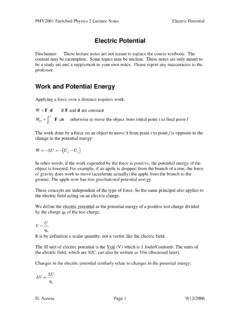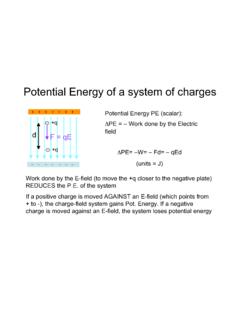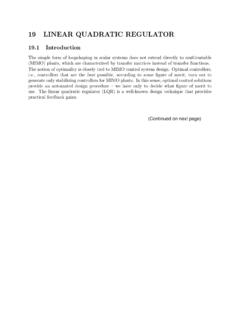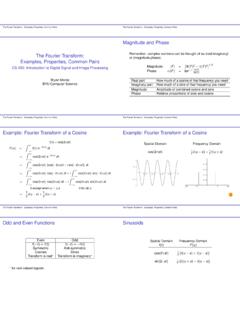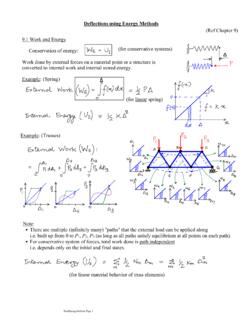Transcription of Chapter 6: Work, Energy and Power - Florida State University
1 Chapter 6: Work, Energy and Power Tuesday February 10th Reading: up to page 88 in the text book (Ch. 6) Finish Newton s laws and circular motion Energy Work (definition) Examples of work Work and Kinetic Energy Conservative and non-conservative forces Work and Potential Energy Conservation of Energy As usual iclicker, examples and demonstrations Although the speed, v, does not change, the direction of the motion does, , the velocity, which is a vector, does change. Thus, there is an acceleration associated with the motion. We call this a centripetal acceleration. ac=v2rCentripetal acceleration: A vector that is always directed towards the center of the circular motion, , it s direction changes constantly. Newton's 2nd law and uniform circular motion (uniform circular motion) Although the speed, v, does not change, the direction of the motion does, , the velocity, which is a vector, does change.
2 Thus, there is an acceleration associated with the motion. We call this a centripetal acceleration. Fc=mac=mv2r(uniform circular motion) Centripetal force: Period:T=2 rv(sec)Frequency:f=1T=12 vr(sec 1)Newton's 2nd law and uniform circular motion The vectors !a,!F,!v and !r are constantly changing Examples of centripetal forces: gravity on an orbiting body; the tension in a string when you swirl a mass in around in a circle; friction between a car's tires and the racetrack as a racing car makes a tight The magnitudes a, F, v and r are constants of the motion. The frame in which the mass is moving is not inertial, , it is accelerating. Therefore, one cannot apply Newton's laws in the moving frame associated with the mass. However, we can apply Newton's laws from the stationary lab frame. Newton's 2nd law and uniform circular motion So why do you appear weightless in orbit?
3 M a=g F=mgSo why do you appear weightless in orbit? m vo a=g F=mgSo why do you appear weightless in orbit? m v(t) a=g F=mgSo why do you appear weightless in orbit? mSo why do you appear weightless in orbit? m Fc=mgYou are in constant free-fall! Looping the loop v(t) Fg N2var= v(t) Fg, N2var=- . ) # & ' 1 & ( & :6 A6 1 7 ' 1 ( ( & & 0v Daytona 500: the racetrack is covered in ice (!), so the physicist cannot rely on friction to prevent him/her from sliding off. How is it that he/she can continue the race? N - . ) # & ' 1 & ( & :6 A6 1 7 ' 1 ( ( & & 0v Daytona 500: the racetrack is covered in ice (!), so the physicist cannot rely on friction to prevent him/her from sliding off. How is it that he/she can continue the race? N ac Energy Energy is a scalar* quantity (a number) that we associate with a system of objects, , planets orbiting a sun, masses attached to springs, electrons bound to nuclei, etc.))))
4 Forms of Energy : kinetic, chemical, nuclear, thermal, electrostatic, It turns out that Energy possesses a fundamental characteristic which makes it very useful for solving problems in physics: ** Energy is ALWAYS conserved** Kinetic Energy K is Energy associated with the State of motion of an object. The faster an object moves, the greater its kinetic Energy . Potential Energy U represents stored Energy , , in a spring. It can be released later as kinetic Energy . *This can make certain kinds of problem much easier to solve mathematically. If you accelerate an object to a greater speed by applying a force on the object, you increase its kinetic Energy K; you performed work on the object. Similarly, if you decelerate an object, you decrease its kinetic Energy ; in this situation, the object actually did work on you (equivalent to you doing negative work). Work W is the Energy transferred to or from an object by means of a force acting on the object.
5 Energy transferred to the object is positive work, and Energy transferred from the object is negative work. Work - Definition Work - Definition If an object moves in response to your application of a force, you have performed work. The further it moves under the influence of your force, the more work you perform. There are only two relevant variables in one dimension: the force, Fx, and the displacement, x. Work W is the Energy transferred to or from an object by means of a force acting on the object. Energy transferred to the object is positive work, and Energy transferred from the object is negative work. Work - Definition There are only two relevant variables in one dimension: the force, Fx, and the displacement, x. Work W is the Energy transferred to or from an object by means of a force acting on the object. Energy transferred to the object is positive work, and Energy transferred from the object is negative work.
6 W=Fx xDefinition: [Units: or Joule (J)] Fx is the component of the force in the direction of the object s motion, and x is its displacement. Examples: Pushing furniture across a room; Carrying boxes up to your attic. Work - Examples N Mg Frictionless surface x W=Fx xFx Work - Examples N Mg Rough surface x WPull=Fx fk xfk These two seemingly similar examples are, in fact, quite different Fx Work - Examples Fx Frictionless surface x 12mvf2 12mvi2=12m 2ax x K=Kf Ki=max x=Fx x=WWhat happens next? vf2=vi2+2ax xKinetic Energy - Definition Fx Frictionless surface x K=12mv2 12mvf2 12mvi2=12m 2ax x K=Kf Ki=max x=Fx x=WWork-Kinetic Energy Theorem K=Kf Ki=Wnetchange in the kineticnet work done on Energy of a particle the particle = Kf=Ki+Wnet kinetic Energy after kinetic Energy the netthe net work is donebefore the net workwork done =+ F N Mg Frictionless surface x W=Fx x=Fcos xMore on Work Fx=Fcos W=Fdcos W=!
7 F !dMore on Work To calculate the work done on an object by a force during a displacement, we use only the force component along the object's displacement. The force component perpendicular to the displacement does zero work Caution: for all the equations we have derived so far, the force must be constant, and the object must be rigid. I will discuss variable forces later. The scalar product, or dot product !a !b=abcos (a)(bcos )=(acos )(b)cos =cos( ) !a !b=!b !a The scalar product represents the product of the magnitude of one vector and the component of the second vector along the direction of the first If =0o, then !a !b=ab If =90o, then !a !b=0 The scalar product, or dot product !a !b=abcos (a)(bcos )=(acos )(b)cos =cos( ) !a !b=!b !a The scalar product becomes relevant in Chapter 6 (pages 88 and 97) when considering work and Power . There is also a vector product, or cross product, which becomes relevant in Chapter 11 (pages 176-178).
8 I save discussion of this until later in the semester. See also Appendix A.
